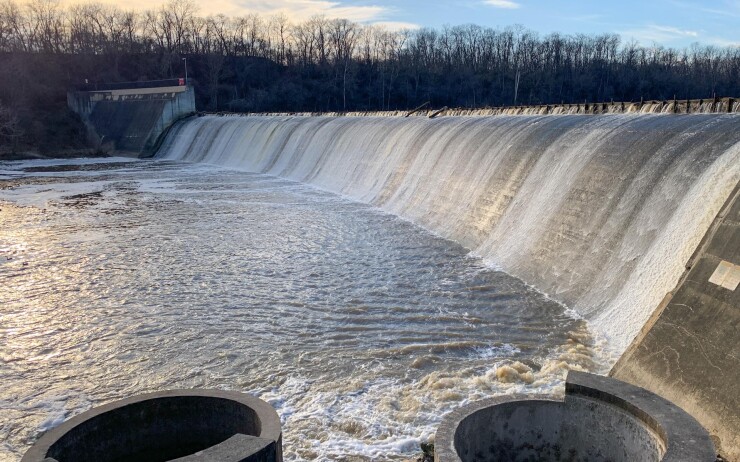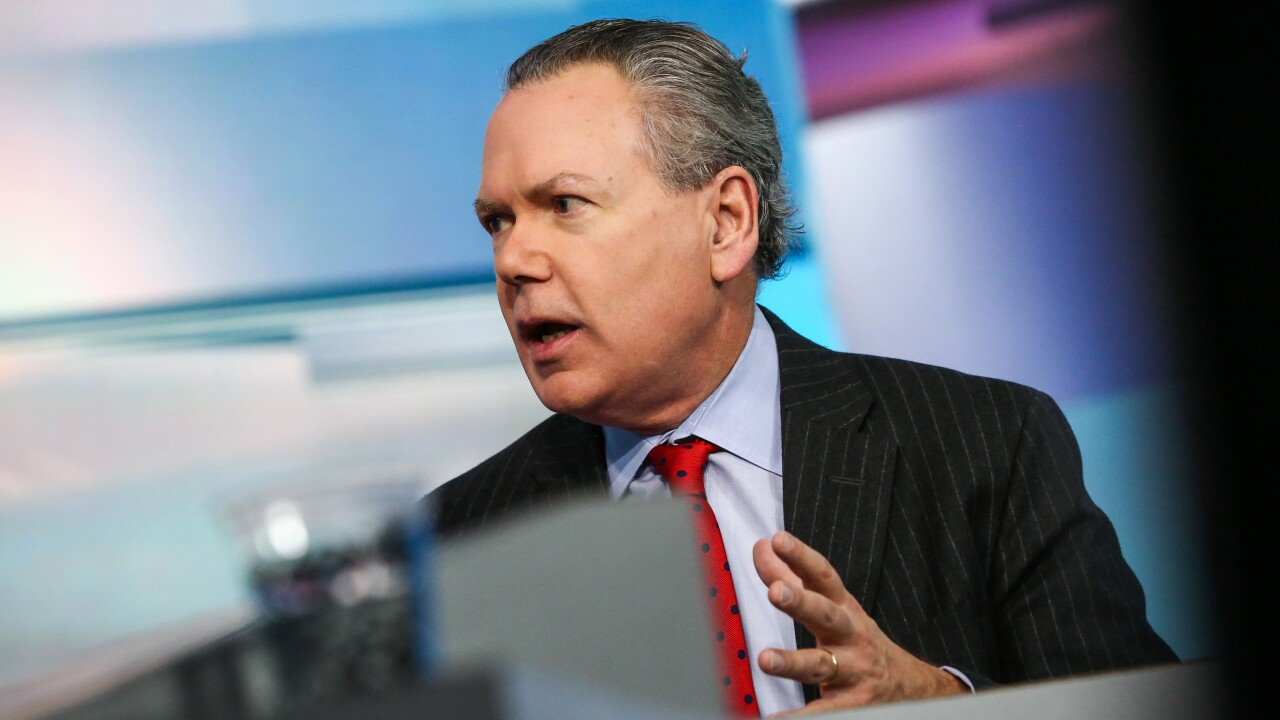The Ohio Water Development Authority was scheduled to return to market Tuesday with triple-A-rated revenue bonds, including $400 million of new money green bonds.
New money proceeds will reimburse the agency for loans financing wastewater, stormwater and water pollution prevention projects.
The OWDA jointly administers, with the Ohio Environmental Protection Agency, the state's bond-funded wastewater and drinking water revolving loan programs. It also runs its own bond-funded revolving loan program, the Fresh Water Program.

The authority is also issuing refunding bonds after conducting a tender offer.
OWDA Executive Director Michael Fraizer said he and his team were finalizing the tender transaction as of Tuesday afternoon. The authority accepted $121 million of tendered bonds, according
"Given that there's no longer an option to advance refund our bonds on a tax-exempt basis, the tender gives us the option to current refund the bonds," he said. "We're looking for aggregate savings of at least 4%."
The green bonds were verified via a second party opinion from Kestrel, an observer for the International Capital Markets Association. Kestrel is also accredited by the Climate Bonds Initiative, a low-carbon policy and market intelligence nonprofit based in London.
"I can't speak for other states, but it is my understanding that there is the opportunity to self-declare," Fraizer said, noting that the proceeds of these bonds have always been used to fund improvements to the quality of water in Ohio, which made them eligible for the green bonds designation.
"The OWDA sees it as a check and balance, versus a self-declare," he said. "So the outside entity can substantiate it."
The OWDA's new money Series 2024D water pollution control loan fund revenue bonds are fixed-rate and tax-exempt. Upon closing, proceeds will immediately go to reimburse the authority for 354 Water Pollution Control Loan Fund loans made to 188 local government borrowers, according to a Sept. 23 investor presentation.
The senior manager on the deal is RBC Capital Markets and co-senior manager is Bank of America. The municipal advisor is PFM Financial Advisors. Bond counsel is Squire Patton Boggs.
The authority will also issue roughly $200 million of WPCLF refunding revenue bonds, Series 2024E. Those bonds are tender option refunding bonds targeting certain maturities from the authority's series 2017A and 2019B bonds. The tender offer was made with the help of RBC Capital Markets, LLC, as dealer manager, with Monday the deadline for all offers for purchase.
Both Moody's Ratings and S&P Global Ratings assign their top triple-A ratings and stable outlooks.
Moody's said in a rating report that its rating reflects the WPCLF's very high level of overcollateralization and the size and diversity of the WPCLF and Drinking Water Assistance Fund's combined loan pool.
According to the investor presentation, there's a coverage pledge of 1.00x coverage from existing loan interest repayment for WPCLF bonds debt service and 1.00x coverage from existing principal repayments. There is also cross-collateralization through investment between the WPCLF and DWAF programs. And the authority has covenanted to its bondholders that it will take all necessary actions to collect all loan payments due.
Moody's Vice President and Senior Analyst Omar Ouzidane noted there is no debt service reserve fund because all state revolving funds have moved to a cash flow model in which loans ensure the overcollateralization.
S&P credit analysts John Schulz and Peter Murphy said by email that the bonds are secured by repayments from loans provided to local municipalities and pointed to the cross-collateralization.
"The pledged loans of $10.8 billion far exceed the $7.8 million in outstanding debt service, and the loans provide strong coverage," they said. "The fund also has access to combined funds of about $1.78 billion, which is more than sufficient to pass for our extreme stress scenarios."
S&P also affirmed its AAA and AAA/A1-plus ratings on OWDA's outstanding WPCLF and DWAF revenue bonds and noted that the DWAF portfolio includes 278 borrowers with $2.4 billion of debt. In
Projects financed by the 2024D green bonds include an effort to reduce phosphorus and nitrogen pollution in water so as to mitigate harmful algae blooms. Another project involves wastewater treatment system improvements; another, stormwater management projects; yet another, repairs of household sewage treatment systems.
There are projects to promote regional consolidation among independent entities in order to provide more efficient, centralized service. And to reduce the potential for sewage overflows, there are projects to eliminate pollution-prone combined sewers by building separate systems.
Kestrel's second party opinion — included in the Sept. 23
Through the Clean Water Act, the U.S. EPA makes capitalization grants to states for use in their water pollution control revolving funds. To get such grants, the states have to chip in a state match totaling 20% of the federal grant.
Ohio's WPCLF has made over $9.8 billion in loans since it launched, using federal capitalization grants, state match monies, bond proceeds and loan repayments. The WPCLF portfolio currently includes about $7.1 billion of pledged loans outstanding to 361 different borrowers for 1,285 projects.
The top local government agencies by percent of projected total remaining repayments are Columbus, with 158 projects and $1.573 billion of remaining WPCLF repayments; Akron, with 64 projects and $1.405 billion of remaining WPCLF repayments; and the Northeast Ohio Regional Sewer District, with 59 projects and $1.304 billion of remaining WPCLF repayments.
Prior to the issuance of these bonds, the OWDA had $3.66 billion of WPCLF revenue bonds outstanding. That includes
The Bipartisan Infrastructure Law signed by President Joe Biden in 2021 has boosted the supply of funding available for clean water programs. Since 2022, the OWDA has received a regular grant of $42.2 million and a BIL grant of $117.34 million.
The WPCLF's capitalization grant amounts jumped from $89.46 million in 2020 and $89.44 million in 2021 to $165.3 million in 2022 and $159.57 million in 2023.
The OWDA is overseen by eight members, five of whom are appointed by the governor for eight-year terms. The remaining three are the Director of Environmental Protection, the Director of Natural Resources and the Director of the Development Services Agency.
A spokesperson for Ohio EPA Director Anne Vogel declined to comment. DNR Director Mary Mertz referred all questions to the OWDA.
According to a
By Dec. 31, there was a $5.5 trillion global market in green, social, sustainability and sustainability-linked bonds. Green bonds made up $2.8 trillion of that. About 80% of the global GSS bond market was aligned with CBI's screening methodology.
But green bond issuance in the U.S. and Canada — the CBI doesn't distinguish between municipal and corporate debt — declined 22% last year. The U.S. was the number-three source of aligned green bonds, credited with $59.9 billion.
That happened against a backdrop of global growth: aligned green debt increased 15.23% globally from 2022 to 2023.
"The U.S. green bond market has been marked by a notable prevalence of smaller deals from numerous issuers," the report notes. "In 2023, 1,231 deals were priced in the US market with an average deal size of $48.6 million."





